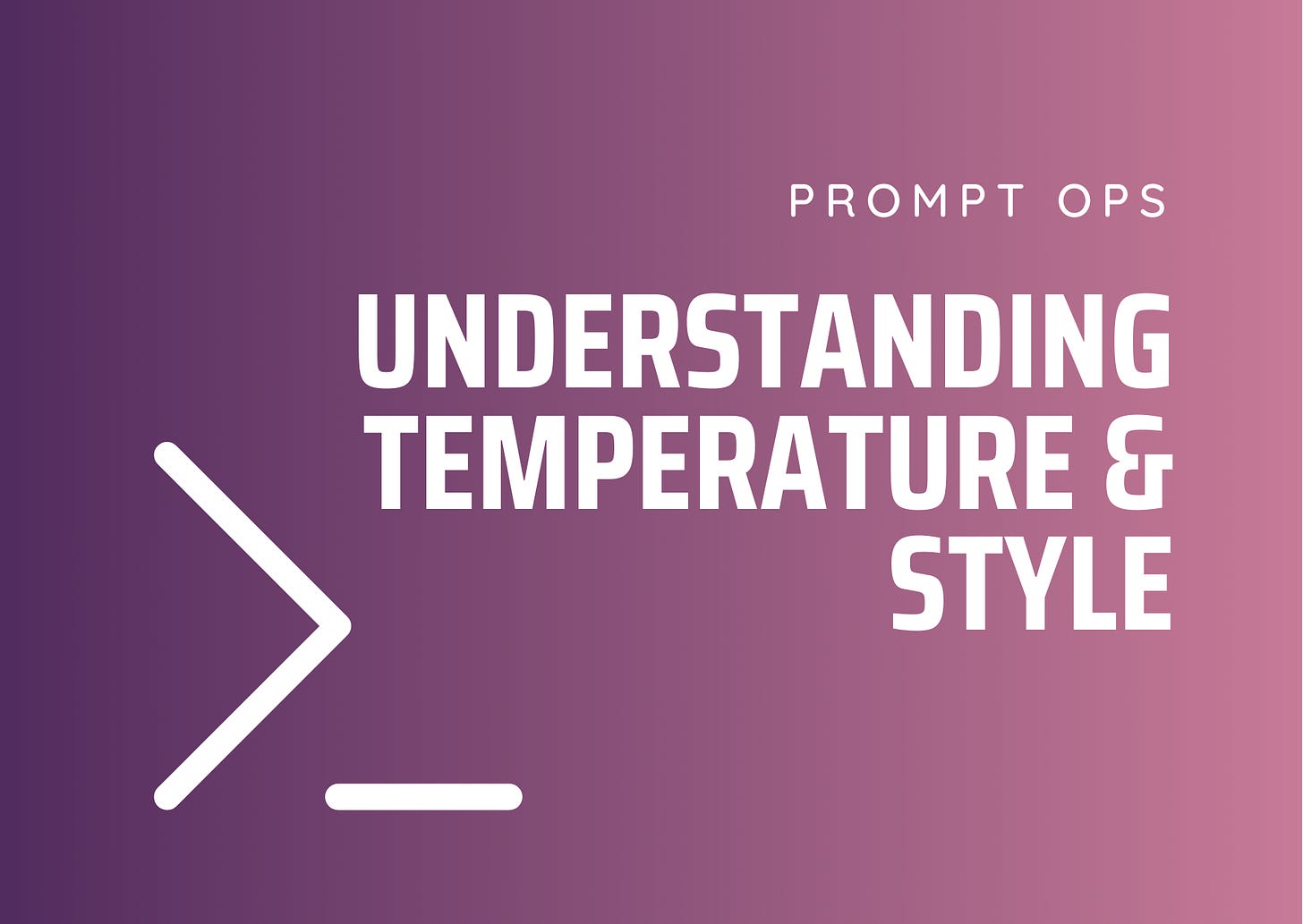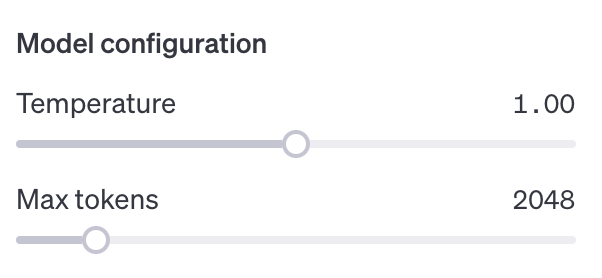Understanding Temperature & Style in Prompt Design
Lesson 7: Creating style prompt blocks that work
This is a subsection of Cyborgs Writing. If you are not interested in PromptOps, you can unsubscribe from this section in your Substack settings and still receive other content.
In our previous lesson, we explored how rhetoric shapes our interactions with AI, particularly through structured prompt blocks. One of these crucial blocks is [STYLE] - but this raises an intriguing question:
What exactly is style, and how does AI interpret and generate it?
Style has been a subject of debate among rhetoricians for centuries. While we often talk about style as something we "have," it's more accurate to think of style as something we "do" - an active process of adapting our communication to fit specific relationships and contexts.
Our style shifts naturally when we're:
Writing an email to a colleague versus texting a friend
Explaining a concept to experts versus newcomers
Crafting formal documentation versus brainstorming ideas
This dynamic nature of style presents a fascinating challenge when working with AI. When we use a [STYLE] block in our prompts, we're essentially asking AI to perform a specific kind of linguistic adaptation.
This brings up a host of questions that I’m not sure can be entirely answered … but they can be tested.
How does AI interpret style directives? Can AI truly adapt to contextual nuances? Does AI have enough contextual awareness to make appropriate stylistic choices?
And most importantly: How can we guide AI's word choices to achieve different styles while maintaining coherence and purpose?
While we often talk about style as something we "have," it's more accurate to think of style as something we "do" - an active process of adapting our communication to fit specific relationships and contexts.
What is Style?
Style is one of the most complex concepts in rhetoric and writing. As Kate Ronald explains in her essay "Style: The Hidden Agenda in Composition Classes," style isn't just about word choice or sentence structure - it's about establishing a "presence" on the page, creating a genuine connection between writer and reader.
This is why combining explicit style guidance with AI tools, like temperature control, becomes crucial when working with AI, especially at scale when developing AI writing systems. Rather than expecting AI to understand style intuitively, we can use these tools together to guide its outputs more effectively.
In the creator economy, I consider this a key aspect of creating authenticity — or ethos. Whether you are a creator or working for a business, ethos is going to be a key to succeeding in a world where people expect authentic interaction, not just content.
And with the rise of AI, this ethos or authenticity will be even more difficult to achieve.
That’s why we need to take a closer look at style.
Ronald describes style as "somebody's home in this paper, somebody wants to say something—to me, to herself, to the class, to the community." When we ask AI to adopt a particular style through our prompts, we're really asking it to establish a specific kind of presence or relationship with its audience.
This is far more complex than just adjusting word choice or sentence patterns. Style emerges from the dynamic relationship between:
The writer's voice and authenticity
The reader's needs and expectations
The context and purpose of the writing
The conventions of different communities
As Ronald points out, even seasoned writing teachers struggle with teaching style explicitly because it's so deeply contextual. So I’m not sure why we expect AI to magically achieve this for us.
She notes that while we "recognize good style when we hear it," defining exactly what makes it good is much harder. This same challenge applies to working with AI - we can recognize when an AI's output hits the right stylistic notes, but explicitly instructing it to achieve that style is more complex.
This is where temperature settings become a valuable tool. Rather than relying entirely on direct instructions about style (which, as Ronald shows, is difficult even for human writers), temperature allows us to influence and fine-tune how the AI constructs its responses at a more fundamental level, especially in response to our [STYLE] blocks.
By adjusting the temperature, we can guide the AI toward different kinds of stylistic choices while still allowing space for the natural emergence of voice and presence that characterize effective writing.
Temperature: A Tool for Stylistic Control
Imagine you're at a coffee shop watching a master coffee blender develop specific flavors of coffee. This might mean having buckets full of different kinds of beans … a palette, so to speak.
Each time they make a blend, they need to select beans from these buckets. When making a standard house coffee, they'll consistently choose the most common beans - the ones they know will produce a reliable, familiar cup.
But for their "special choice," they might reach deeper into their palette and combine some unique or rare beans to create something more unexpected.
This is similar to how temperature works in AI language models. When generating text, the AI has a vast collection of possible word choices - like those buckets of coffee beans. For each word in a sequence, the AI assigns probabilities to different possible "next words." Some words are highly probable (like those common coffee beans) while others are less likely choices.
Temperature controls how the AI makes these word selections. Usually, this is a number between 0-2, with 0 being the most predictable. Some apps though don’t show this, but instead give you a “creativity” setting.
This is what the setting looks like in OpenAI’s playground - a place where you can create assistants and adjust many different kinds of settings (no subscription required).
At low temperatures (like our standard house coffee):
The AI becomes very "conservative" in its choices
It consistently picks the words with the highest probability
It's like telling the blender "Just use the regular beans"
This results in more predictable, consistent outputs
At high temperatures (like the coffee blender choice):
The AI becomes more "exploratory" in its selections
It's more willing to choose words with lower probabilities
It's like telling the blender "Feel free to experiment"
This leads to more varied, sometimes unexpected combinations
So while many AI interfaces label temperature as a "creativity" setting, it's really controlling the randomness in the AI's word selection process. The AI isn't becoming more creative in any human sense - it's simply being allowed to sample from a broader range of possibilities in its statistical model.
Rhetorical Approaches to Temperature
When Ronald talks about style in writing, she describes how writers need to adapt their voice depending on who they're writing for and why. Think about how differently you might write:
An email to your boss versus a text to a friend
A formal report versus a social media post
A technical explanation versus a personal story
Each situation calls for a different kind of "presence" on the page. Ronald explains that good writers develop an instinct for matching their writing style to these different situations. They know when to be formal or casual, detailed or concise, technical or conversational.
This is exactly where temperature settings become valuable when working with AI. Instead of trying to explain all these subtle stylistic choices to the AI, we can use temperature to guide how the AI approaches different writing styles.
Understanding temperature this way helps us see why it can be such a useful tool for controlling style in technical writing or content creation. When we need precise, consistent documentation or instructions, we can use low temperatures to keep the AI focused on the most conventional, clear language patterns. When we want to generate multiple approaches to explaining a concept, we can raise the temperature to explore different phrasings and structures.
But, as we will see later in this lesson, this formula doesn’t always work, especially when you add your on style instructions to your prompt. Just like style is not a static, temperature too can only be used and understood in context.
To help us think through this, let’s take a style heuristic developed by ancient thinkers.
In the ancient world, rhetoricians recognized three distinct levels of style that speakers and writers could employ depending on their purpose. This can be a useful lens through which we think about temperature and style.
Plain Style was used for clear instruction and straightforward communication. This style prioritized precision and clarity over artistry. Think of military commands or legal documents - language that leaves no room for misinterpretation. Writers using plain style wanted their meaning to be immediately clear to their audience.
Middle Style balanced clarity with engagement. It allowed for some artistic flourishes and emotional appeal while maintaining clear communication. This style was perfect for everyday communication that needed to both inform and hold interest - like letters, essays, or public speeches meant to teach and engage.
Grand Style was reserved for moving audiences emotionally and inspiring action. This style employed elaborate language, metaphors, and other artistic devices to create powerful emotional effects. Orators would use grand style when they wanted to stir their audience's hearts as well as their minds.
These ancient insights about style seem to map well onto how we can use temperature settings with AI, but as you will see later in this lesson … it gets a bit more complicated. But it is a good starting point.
Just as ancient rhetoricians chose their style based on their purpose, we can adjust temperature settings to help AI generate content that matches our goals:
Low Temperature (0.2 - 0.4) aligns with Plain Style:
Prioritizes clarity and precision
Consistently chooses the most standard, conventional language
Perfect for technical documentation, instructions, or any writing where accuracy is crucial
Minimizes artistic flourishes in favor of clear communication
Middle Temperature (0.5 - 0.7) parallels Middle Style:
Balances clarity with engagement
Allows for some variation and creativity while maintaining focus
Ideal for blog posts, user guides, or any content that needs to both inform and interest readers
Creates a conversational yet professional tone
High Temperature (0.8 - 1.0) corresponds to Grand Style:
Maximizes creative expression
Explores more varied and unusual language combinations
Best for brainstorming, creative writing, or content meant to inspire
Produces more diverse and exploratory outputs
Note: Dialing temperature at the extreme ends, 0 or 2, usually takes the AI off the rails, though sometimes can producing interesting connections. For 0, you will see a lot of repetition. And for 2, you’ll see a lot of nonsense. Its actually a good way to see how temperature works.
This connection between classical rhetoric and AI temperature settings isn't just theoretical - it gives us practical guidance for choosing the right temperature for different writing tasks.
Just as ancient orators carefully chose their style based on their purpose and audience, we can adjust temperature settings to help AI generate content that establishes the right kind of presence for our purpose.
These ancient insights about style map surprisingly well onto AI writing, though not always in the ways we might expect. Through testing, I discovered that different styles often work best at unexpected temperature ranges
Let's look at some specific examples of how these different temperature ranges work in practice.
➡️ Paid subscribers can also see the prompt blocks I used in the Prompt Lab.
Keep reading with a 7-day free trial
Subscribe to Cyborgs Writing to keep reading this post and get 7 days of free access to the full post archives.




